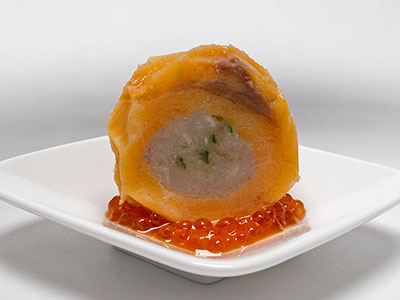December 10, 2012
Amuse-Bouche

roue de saumon
(salmon wheel)
Given all the fish in the ocean, it hard to believe that there is such a small variety available at most markets. Even with the limited selection we face today, it’s nothing like it was when I was growing up in the 1950s. I don’t know if the absolute number of fish species available was less back then, but I know that not many of them made it to our family’s dinner table.
There were only three fish to choose from in our house: halibut, sole, and salmon. When we had halibut it was always baked in a little butter with a bit of minced parsley on top. The halibut was always dry. The sole was pan-fried in butter and served drenched with the same butter. The sole always had a slight fishy taste. The salmon was always poached. It was edible.
What made my mother’s salmon edible was the sauce she served with it. She prepared a velouté from the poaching liquid. This was flavored with mustard and garnished with diced, hard-cooked eggs. The sauce had a velvety mouthfeel and a pleasant taste. The salmon, eaten by itself was dry and overcooked, but the sauce made it desirable.
Occasionally in those early days, I’d get a few bites of smoked salmon at one celebration or another, but that was still less frequent than the cooked salmon. Back then, the only smoked salmon I knew was the cold-smoked variety called lox.
Move forward half a century and I’m eating raw salmon in various forms. Then in 2009, I was introduced to salmon in a form I had never experienced before. The Saturday-night meal at the Oxford Symposium on Food and Cooking that year was prepared by Raymond Blanc and the staff of his Le Manoir aux Quat’Saisons. One of the dishes he served was a small, thick square of salmon—not more than a couple of bites. The salmon looked raw, but it wasn’t cold. It had been heated to the point where it felt warm in your mouth, but the texture was still like raw. Amazing.
Rather than just duplicate that dish as an amuse-bouche, I decided to combine the idea with another dish I prepare as a pass-around hors d’oeuvre and one that I prepare as a fish sausage. This is a dish prepared more by feel than with exact measurements, but I’ve tried to give an indication of the quantities used. Just about any of the ingredients can be replaced with similar ones.
4 small (36-40 size)
raw, headless shrimp, peeled, vein removed
4
bay scallops
125 g (5 oz)
white fish fillet, such as basa, swai, or catfish
fine salt, to taste
ground white pepper, to taste
transglutaminase (Activa RM)
finely sliced
fresh sage
225 g (8 oz)
fresh salmon fillet
salmon caviar [optional]
1. Grind the shrimp, scallops, and whitefish through the fine plate of a hand-crank meat grinder. Add the salt, pepper, transglutaminase (see note below), and sage. Mix with a rubber spatula, mostly in one direction, until the mixture becomes a little sticky.
2. Lay a large piece of plastic film on your work surface, and arrange a long stripe of the fish mixture along the long edge, about 5 cm (2 in) in. Fold the plastic over the fish and use a flat, plastic scraper to push the mixture into a 12-mm (1⁄2-in) diameter “log.” There should not be any significant air bubbles visible through the plastic. Roll the film up around the mixture. Twist the loose ends to tighten the mixture inside into a long sausage shape, but maintain the original diameter. Place the fish sausage in your freezer until solid.
3. When the log is solid, arrange another piece of plastic wrap on your work surface like the previous one. Slice the salmon into very thin slices, parallel to the skin. Only use the flesh, discard the skin. On the plastic, arrange the salmon pieces in a rectangular shape that is the same length as the frozen fish sausage. Keep the overlap to a minimum, and sprinkle the areas that do overlap with a light coating of transglutaminase to bond the slices of salmon together. Once the rectangle is created, remove the frozen sausage from your freezer and unwrap it. Sprinkle the entire surface of the salmon rectangle with a coating of transglutaminase. Place the fish sausage on the near edge and, using the plastic film as an aid, roll the salmon tightly around it. Twist the ends of the plastic to once again form a log. Refrigerate for 4 hours to allow the transglutaminase time to bond everything together.
4. Slice the salmon log into 18-mm (7⁄10-in) thick disks. Arrange the disks on a sheet pan lined with parchment paper, and freeze until firm.
5. Once frozen, vacuum pack the disks in packages of four.
6. For service, thoroughly thaw the frozen salmon disks in their packaging. Heat them, still in their packaging, in a water bath set to 41 °C (106 °F) until warmed all the way through, about 30 minutes.
7. Serve the disks on edge, sitting on a layer of salmon caviar.
Note: Transglutaminase is an enzyme that bonds proteins together. It can be applied as a slurry or just as a powder. In either case, it doesn’t take much to glue the proteins together. To sprinkle the transglutaminase on the surface of the fish, use a small strainer and spoon to ensure that a somewhat thin layer that mostly covers is produced. For the sausage meat early in the recipe, sprinkle the transglutaminase over the surface of the mixture, and then mix it in like the salt and pepper.
Yield: about 12 servings.
© 2012 Peter Hertzmann. All rights reserved.
